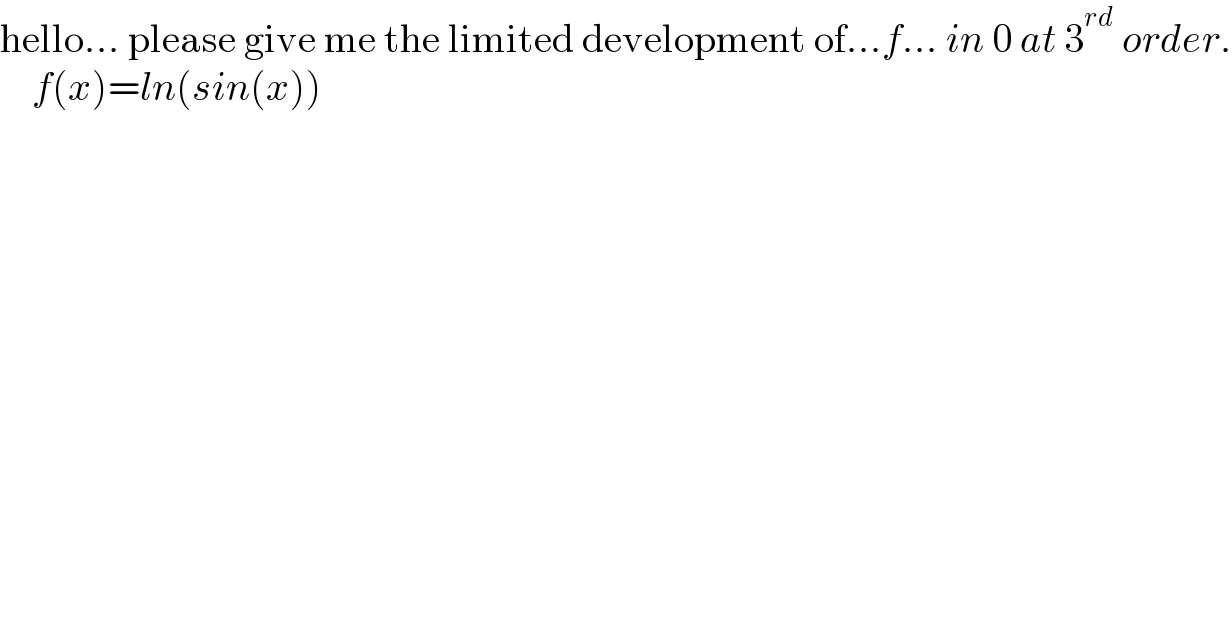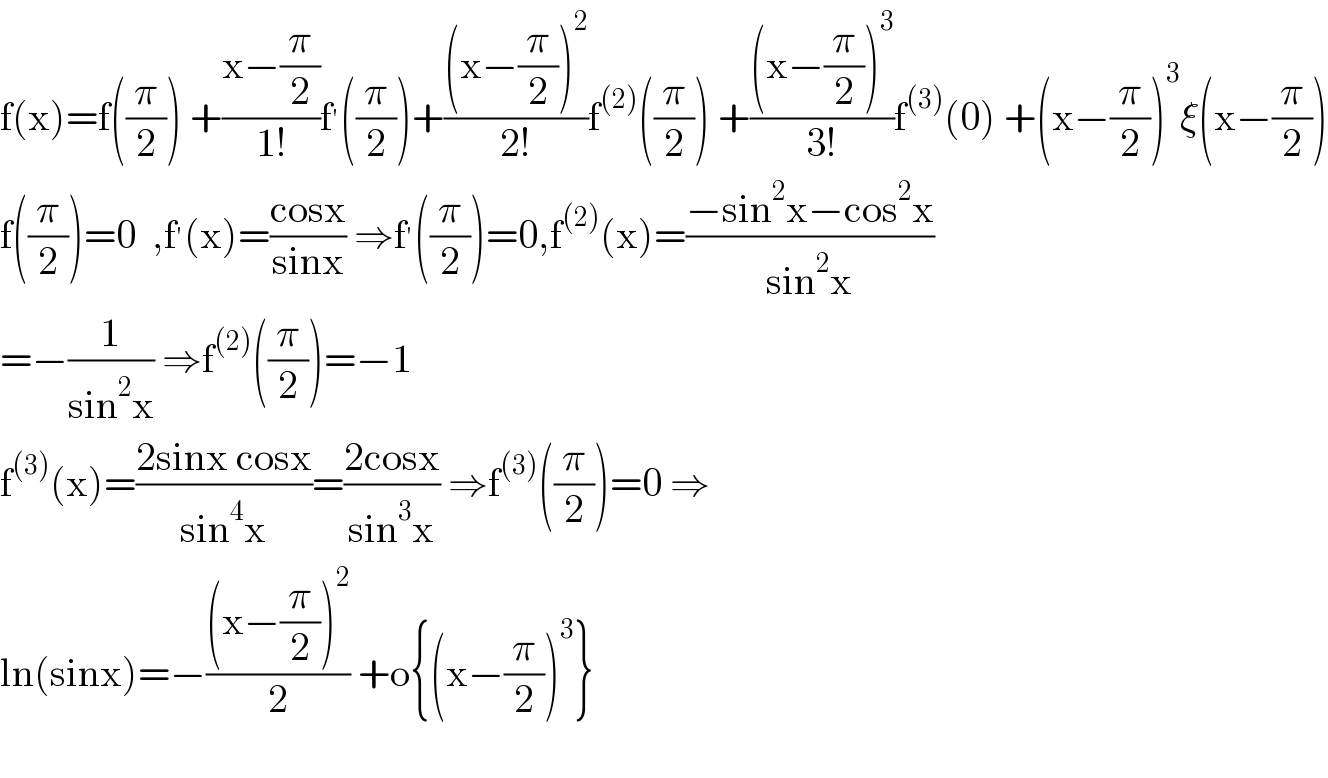
Question Number 130303 by stelor last updated on 24/Jan/21

$$\mathrm{hello}...\:\mathrm{please}\:\mathrm{give}\:\mathrm{me}\:\mathrm{the}\:\mathrm{limited}\:\mathrm{development}\:\mathrm{of}...{f}...\:{in}\:\mathrm{0}\:{at}\:\mathrm{3}^{{rd}} \:{order}. \\ $$$$\:\:\:\:{f}\left({x}\right)={ln}\left({sin}\left({x}\right)\right) \\ $$$$ \\ $$
Commented by stelor last updated on 24/Jan/21

$$\mathrm{developpement}\:\mathrm{limite}\:\mathrm{en}\:\frac{\Pi}{\mathrm{2}}\:\mathrm{a}\:\mathrm{l}'\mathrm{ordre}\:\mathrm{3}. \\ $$
Answered by mathmax by abdo last updated on 24/Jan/21

$$\mathrm{f}\left(\mathrm{x}\right)=\mathrm{f}\left(\frac{\pi}{\mathrm{2}}\right)\:+\frac{\mathrm{x}−\frac{\pi}{\mathrm{2}}}{\mathrm{1}!}\mathrm{f}^{'} \left(\frac{\pi}{\mathrm{2}}\right)+\frac{\left(\mathrm{x}−\frac{\pi}{\mathrm{2}}\right)^{\mathrm{2}} }{\mathrm{2}!}\mathrm{f}^{\left(\mathrm{2}\right)} \left(\frac{\pi}{\mathrm{2}}\right)\:+\frac{\left(\mathrm{x}−\frac{\pi}{\mathrm{2}}\right)^{\mathrm{3}} }{\mathrm{3}!}\mathrm{f}^{\left(\mathrm{3}\right)} \left(\mathrm{0}\right)\:+\left(\mathrm{x}−\frac{\pi}{\mathrm{2}}\right)^{\mathrm{3}} \xi\left(\mathrm{x}−\frac{\pi}{\mathrm{2}}\right) \\ $$$$\mathrm{f}\left(\frac{\pi}{\mathrm{2}}\right)=\mathrm{0}\:\:,\mathrm{f}^{'} \left(\mathrm{x}\right)=\frac{\mathrm{cosx}}{\mathrm{sinx}}\:\Rightarrow\mathrm{f}^{'} \left(\frac{\pi}{\mathrm{2}}\right)=\mathrm{0},\mathrm{f}^{\left(\mathrm{2}\right)} \left(\mathrm{x}\right)=\frac{−\mathrm{sin}^{\mathrm{2}} \mathrm{x}−\mathrm{cos}^{\mathrm{2}} \mathrm{x}}{\mathrm{sin}^{\mathrm{2}} \mathrm{x}} \\ $$$$=−\frac{\mathrm{1}}{\mathrm{sin}^{\mathrm{2}} \mathrm{x}}\:\Rightarrow\mathrm{f}^{\left(\mathrm{2}\right)} \left(\frac{\pi}{\mathrm{2}}\right)=−\mathrm{1} \\ $$$$\mathrm{f}^{\left(\mathrm{3}\right)} \left(\mathrm{x}\right)=\frac{\mathrm{2sinx}\:\mathrm{cosx}}{\mathrm{sin}^{\mathrm{4}} \mathrm{x}}=\frac{\mathrm{2cosx}}{\mathrm{sin}^{\mathrm{3}} \mathrm{x}}\:\Rightarrow\mathrm{f}^{\left(\mathrm{3}\right)} \left(\frac{\pi}{\mathrm{2}}\right)=\mathrm{0}\:\Rightarrow \\ $$$$\mathrm{ln}\left(\mathrm{sinx}\right)=−\frac{\left(\mathrm{x}−\frac{\pi}{\mathrm{2}}\right)^{\mathrm{2}} }{\mathrm{2}}\:+\mathrm{o}\left\{\left(\mathrm{x}−\frac{\pi}{\mathrm{2}}\right)^{\mathrm{3}} \right\} \\ $$$$ \\ $$
Commented by mathmax by abdo last updated on 24/Jan/21

$$\mathrm{first}\:\mathrm{line}\:\mathrm{f}^{\left(\mathrm{3}\right)} \left(\frac{\pi}{\mathrm{2}}\right) \\ $$
Commented by stelor last updated on 25/Jan/21

$$\mathrm{merci}........\sqrt{\sqrt{\mathrm{thank}}} \\ $$
